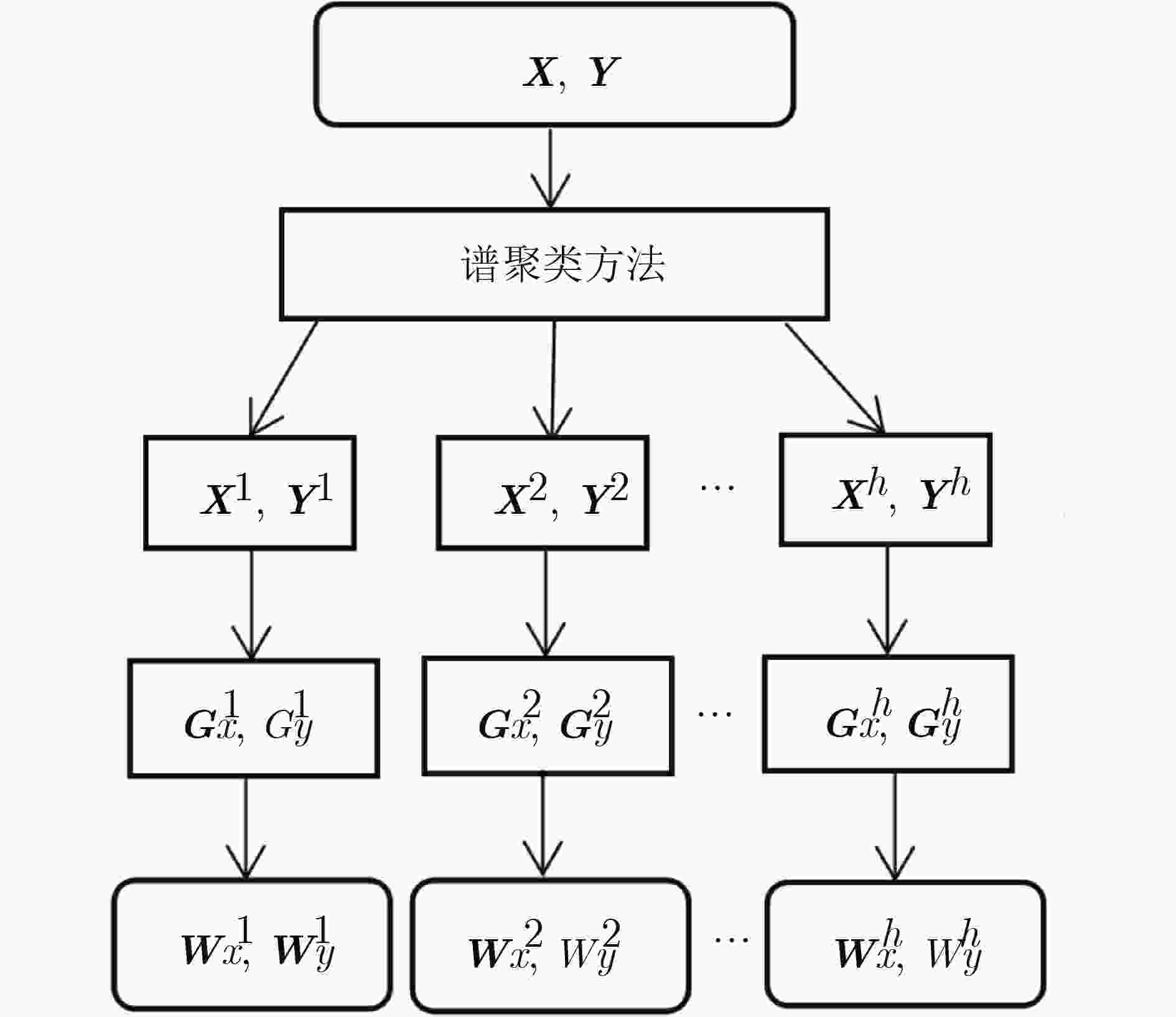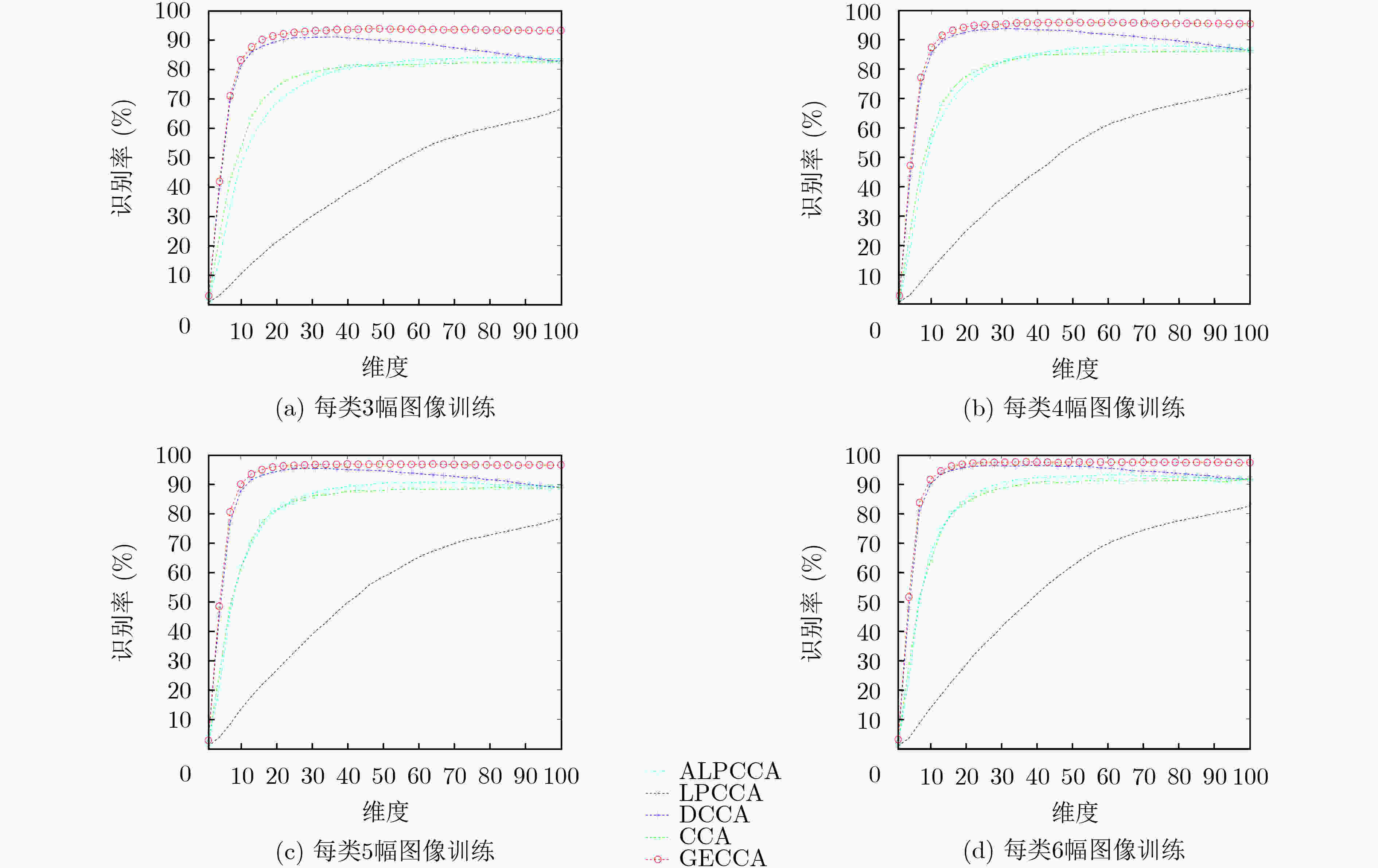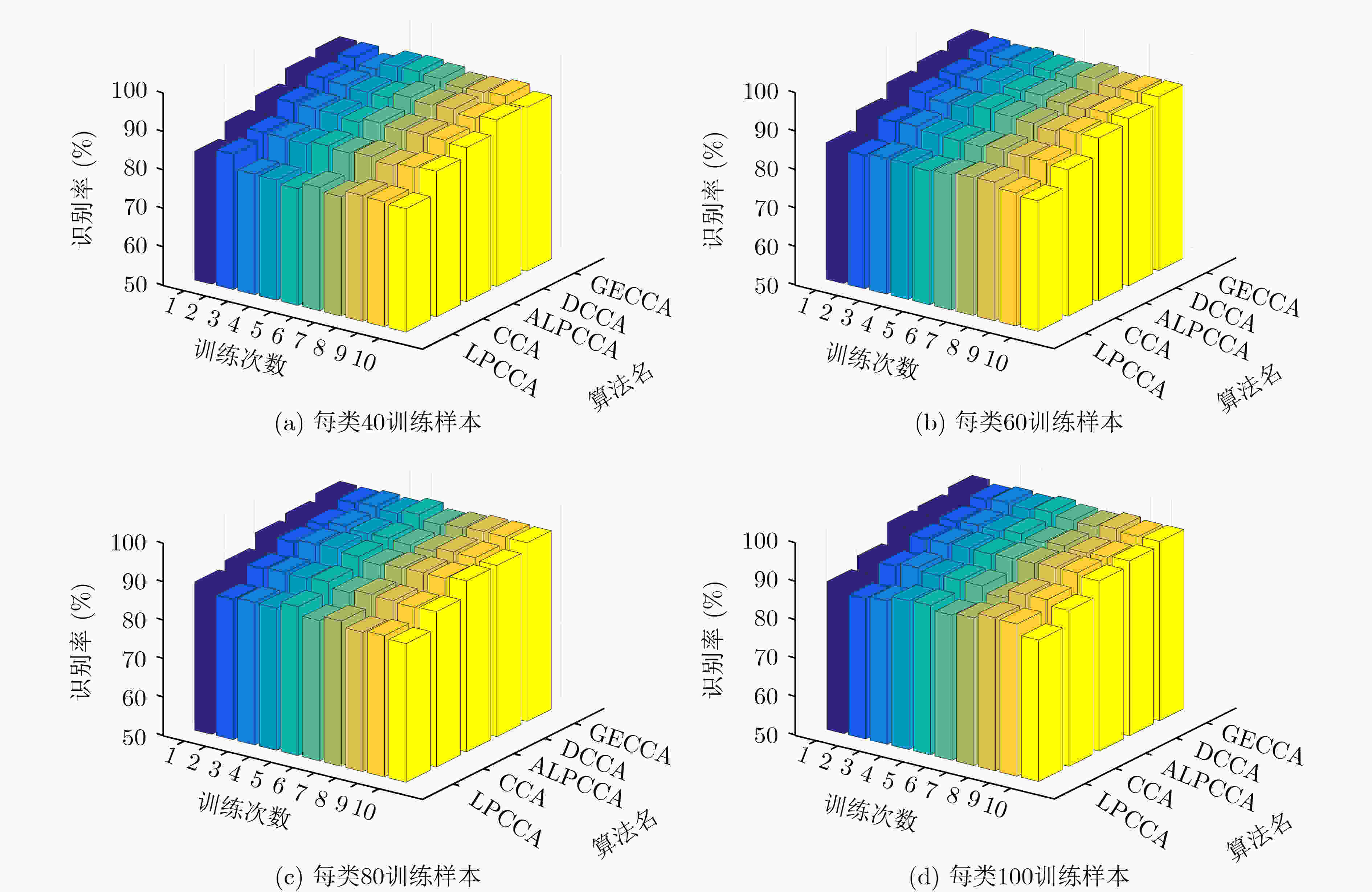Graph Enhanced Canonical Correlation Analysis and Its Application to Image Recognition
-
摘要: 典型相关分析(CCA)作为一种传统特征提取算法已经成功应用于模式识别领域,其旨在找到使两组模态数据间相关性最大的投影方向,但其本身为一种无监督的线性方法,无法利用数据内在的几何结构和监督信息,难以处理高维非线性数据。为此该文提出一种新的非线性特征提取算法,即图强化典型相关分析(GECCA)。该算法利用数据中的不同成分构建多个成分图,有效保留了数据间的复杂流形结构,采用概率评估的方法使用类标签信息,并通过图强化的方式将几何流形和监督信息融合嵌入到典型相关分析框架。为了对该算法进行评估,分别在人脸和手写体数字数据集上设计了针对性实验,良好的实验结果显示出该算法在图像识别中的优势。Abstract: As a traditional feature extraction algorithm, Canonical Correlation Analysis (CCA) has been excellently used for the field of pattern recognition. It aims to find the projection direction that makes the maximum of the correlation between two groups of modal data. However, since the algorithm is an unsupervised linear method, it can not use intrinsic geometry structures and supervised information hidden in data, which will cause difficulty in dealing with high-dimensional nonlinear data. Therefore, this paper proposes a new nonlinear feature extraction algorithm, namely Graph Enhanced Canonical Correlation Analysis (GECCA). The algorithm uses different components of the data to construct multiple component graphs, which retains effectively the complex manifold structures between the data. The algorithm utilizes the probability evaluation method to use class label information, and the graph enhancement method is utilized to integrate the geometry manifolds and the supervised information into the typical correlation analysis framework. Targeted experiments are designed on the face and handwritten digital image datasets to evaluate the algorithm. Good experimental results show the advantages of GECCA in image recognition.
-
表 1 GECCA的算法步骤
算法:图强化典型相关分析 (1) 输入:{X,Y},Cx和Cy。 (2)通过式(12)和式(13)构建图强化矩阵Mx和My。利用式(16)构建类拉普拉斯矩阵Lx, Lx, Lxy和 Lyx。 (3)构建拉格朗日乘子函数:${\boldsymbol{F} }\left( { {\boldsymbol{\alpha} } ,{\boldsymbol{\beta} } } \right) = { {\boldsymbol{\alpha} } ^{\rm{T} } }{\boldsymbol{X} }{ {\boldsymbol{L} }_{ { {xy} } } }{ {\boldsymbol{Y} }^{\rm{T} } }{\boldsymbol{\beta} } - \dfrac{ { { {{\lambda } }_1} } }{2}\left( { { {\boldsymbol{\alpha} } ^{\rm{T} } }{\boldsymbol{X} }{ {\boldsymbol{L} }_{ { {xx} } } }{ {\boldsymbol{X} }^{\rm{T} } }{\boldsymbol{\alpha} } - 1} \right) - \dfrac{ { { {{\lambda } }_2} } }{2}\left( { { {\boldsymbol{\beta} } ^{\rm{T} } }{\boldsymbol{Y} }{ {\boldsymbol{L} }_{ { {yy} } } }{ {\boldsymbol{Y} }^{\rm{T} } }{\boldsymbol{\beta} } - 1} \right)$。 (4)按照式(20)求出特征值λ和对应特征向量(α,β)。 (5)取前d个特征值对应特征向量$\left\{ {\;{ {\left[ { {\boldsymbol{\alpha} } _{ {i} }^{\rm{T} },{\boldsymbol{\beta} } _{ {i} }^{\rm{T} } } \right]}^{\rm{T} } }\; \in { { \boldsymbol{R} }^{1 \times \left( { { {p} } + { {q} } } \right)} } } \right\}_{ { {i} } = 1}^{ {d} }$。 (6)输出:${\boldsymbol{A} } = \left\{ { { {\boldsymbol{\alpha} } _1},{ {\boldsymbol{\alpha} } _2},...,{ {\boldsymbol{\alpha} } _{ {d} } } } \right\} \in { { \boldsymbol{R} }^{ { {p} } \times { {d} } } }$和${\boldsymbol{B} } = \left\{ { { {\boldsymbol{\beta} } _1},{ {\boldsymbol{\beta} } _2},\;...,{ {\boldsymbol{\beta} } _{ {d} } } } \right\} \in { { \boldsymbol{R} }^{ { {q} } \times { {d} } } }$。 表 2 在Semeion手写体数字数据集上的识别率及标准差
40训练样本 60训练样本 80训练样本 100训练样本 GECCA 86.93±0.92 88.89±0.98 90.69±0.77 91.38±0.70 DCCA 85.72±1.02 87.57±1.04 89.14±0.82 80.25±0.91 ALPCCA 80.82±0.75 84.76±1.19 87.92±0.77 89.38±1.03 LPCCA 69.84±2.24 74.83±1.51 77.33±1.47 80.56±2.10 CCA 74.20±0.84 77.93±1.19 80.92±0.85 82.34±1.44 A±B:A表示平局识别率(%),B表示标准差 -
[1] LIU Zhonghua, LAI Zhihui, OU Weihua, et al. Structured optimal graph based sparse feature extraction for semi-supervised learning[J]. Signal Processing, 2020, 170: 107456. doi: 10.1016/j.sigpro.2020.107456 [2] 王肖锋, 孙明月, 葛为民. 基于图像协方差无关的增量特征提取方法研究[J]. 电子与信息学报, 2019, 41(11): 2768–2776. doi: 10.11999/JEIT181138WANG Xiaofeng, SUN Mingyue, and GE Weimin. An incremental feature extraction method without estimating image covariance matrix[J]. Journal of Electronics &Information Technology, 2019, 41(11): 2768–2776. doi: 10.11999/JEIT181138 [3] YI Shuangyan, LAI Zhihui, HE Zhenyu, et al. Joint sparse principal component analysis[J]. Pattern Recognition, 2017, 61: 524–536. doi: 10.1016/j.patcog.2016.08.025 [4] BRO R and SMILDE A K. Principal component analysis[J]. Analytical Methods, 2014, 6(9): 2812–2831. doi: 10.1039/C3AY41907J [5] 刘政怡, 段群涛, 石松, 等. 基于多模态特征融合监督的RGB-D图像显著性检测[J]. 电子与信息学报, 2020, 42(4): 997–1004. doi: 10.11999/JEIT190297LIU Zhengyi, DUAN Quntao, SHI Song, et al. RGB-D image saliency detection based on multi-modal feature-fused supervision[J]. Journal of Electronics &Information Technology, 2020, 42(4): 997–1004. doi: 10.11999/JEIT190297 [6] 姜庆超, 颜学峰. 基于局部−整体相关特征的多单元化工过程分层监测[J]. 自动化学报, 2020, 46(9): 1770–1782.JIANG Qingchao and YAN Xuefeng. Hierarchical monitoring for multi-unit chemical processes based on local-global correlation features[J]. Acta Automatica Sinica, 2020, 46(9): 1770–1782. [7] YANG Xinghao, LIU Weifeng, LIU Wei, et al. A survey on canonical correlation analysis[J]. IEEE Transactions on Knowledge and Data Engineering, 2021, 33(6): 2349–2368. doi: 10.1109/TKDE.2019.2958342 [8] YANG Xinghao, LIU Weifeng, TAO Dapeng, et al. Canonical correlation analysis networks for two-view image recognition[J]. Information Sciences, 2017, 385/386: 338–352. doi: 10.1016/j.ins.2017.01.011 [9] SHEN Xiaobo, SUN Quansen, and YUAN Yunhao. Orthogonal canonical correlation analysis and its application in feature fusion[C]. The 16th International Conference on Information Fusion, Istanbul, Turkey, 2013: 151–157. [10] EL MADANY N E D, HE Yifeng, and GUAN Ling. Human action recognition by fusing deep features with globality locality preserving canonical correlation analysis[C]. 2017 IEEE International Conference on Image Processing, Beijing, China, 2017: 2871–2875. [11] ELMADANY N E D, HE Yifeng, and GUAN Ling. Information fusion for human action recognition via biset/multiset globality locality preserving canonical correlation analysis[J]. IEEE Transactions on Image Processing, 2018, 27(11): 5275–5287. doi: 10.1109/TIP.2018.2855438 [12] WANG Fengshan and ZHANG Daoqiang. A new locality-preserving canonical correlation analysis algorithm for multi-view dimensionality reduction[J]. Neural Processing Letters, 2013, 37(2): 135–146. doi: 10.1007/s11063-012-9238-9 [13] GAO Xizhan, NIU Sujie, and SUN Quansen. Two-directional two-dimensional kernel canonical correlation analysis[J]. IEEE Signal Processing Letters, 2019, 26(11): 1578–1582. doi: 10.1109/LSP.2019.2939986 [14] MELZER T, REITER M, and BISCHOF H. Appearance models based on kernel canonical correlation analysis[J]. Pattern Recognition, 2003, 36(9): 1961–1971. doi: 10.1016/S0031-3203(03)00058-X [15] SUN Tingkai, CHEN Songcan, YANG Jingyu, et al. A supervised combined feature extraction method for recognition[C]. The IEEE International Conference on Data Mining, Pisa, Italy, 2008: 1043–1048. [16] GAO Lei, QI Lin, CHEN Enqing, et al. Discriminative multiple canonical correlation analysis for information fusion[J]. IEEE Transactions on Image Processing, 2018, 27(4): 1951–1965. doi: 10.1109/TIP.2017.2765820 [17] CHEN Jia, WANG Gang, and GIANNAKIS G B. Graph multiview canonical correlation analysis[J]. IEEE Transactions on Signal Processing, 2019, 67(11): 2826–2838. doi: 10.1109/TSP.2019.2910475 [18] CHEN Jia, WANG Gang, SHEN Yanning, et al. Canonical correlation analysis of datasets with a common source graph[J]. IEEE Transactions on Signal Processing, 2018, 66(16): 4398–4408. doi: 10.1109/TSP.2018.2853130 [19] SU Shuzhi, FANG Xianjin, YANG Gaoming, et al. Self-balanced multi-view orthogonality correlation analysis for image feature learning[J]. Infrared Physics & Technology, 2019, 100: 44–51. -






 下载:
下载:





 下载:
下载:
